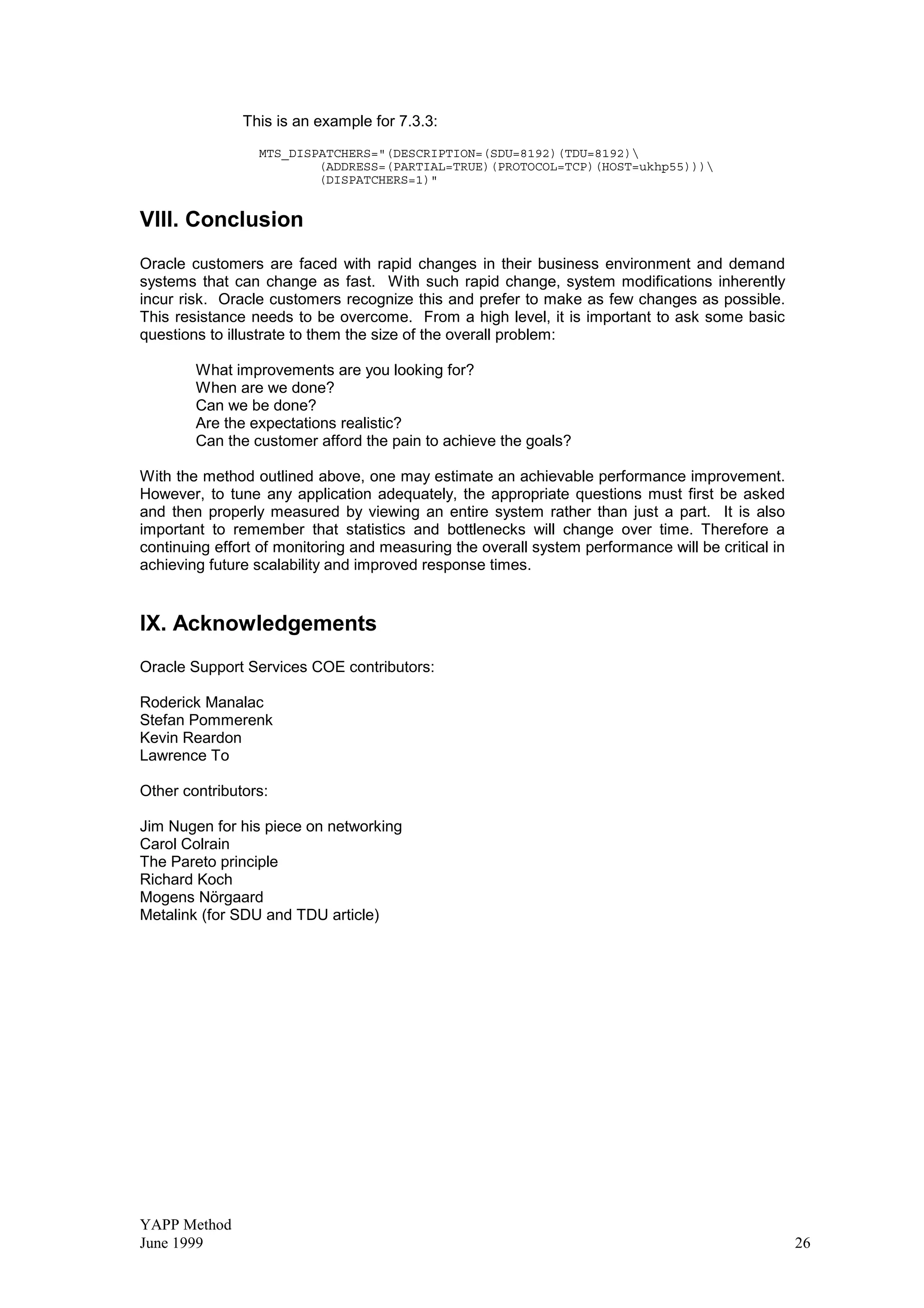This document introduces the Yet Another Performance Profiling Method (YAPP Method) for holistically tuning Oracle database performance. It begins by defining key terms like response time, scalability, and the 80/20 rule. It then explains that most performance issues originate from application design/implementation rather than the database itself. The document advocates focusing tuning efforts on the application level using a simplified approach focused on the areas of highest impact.


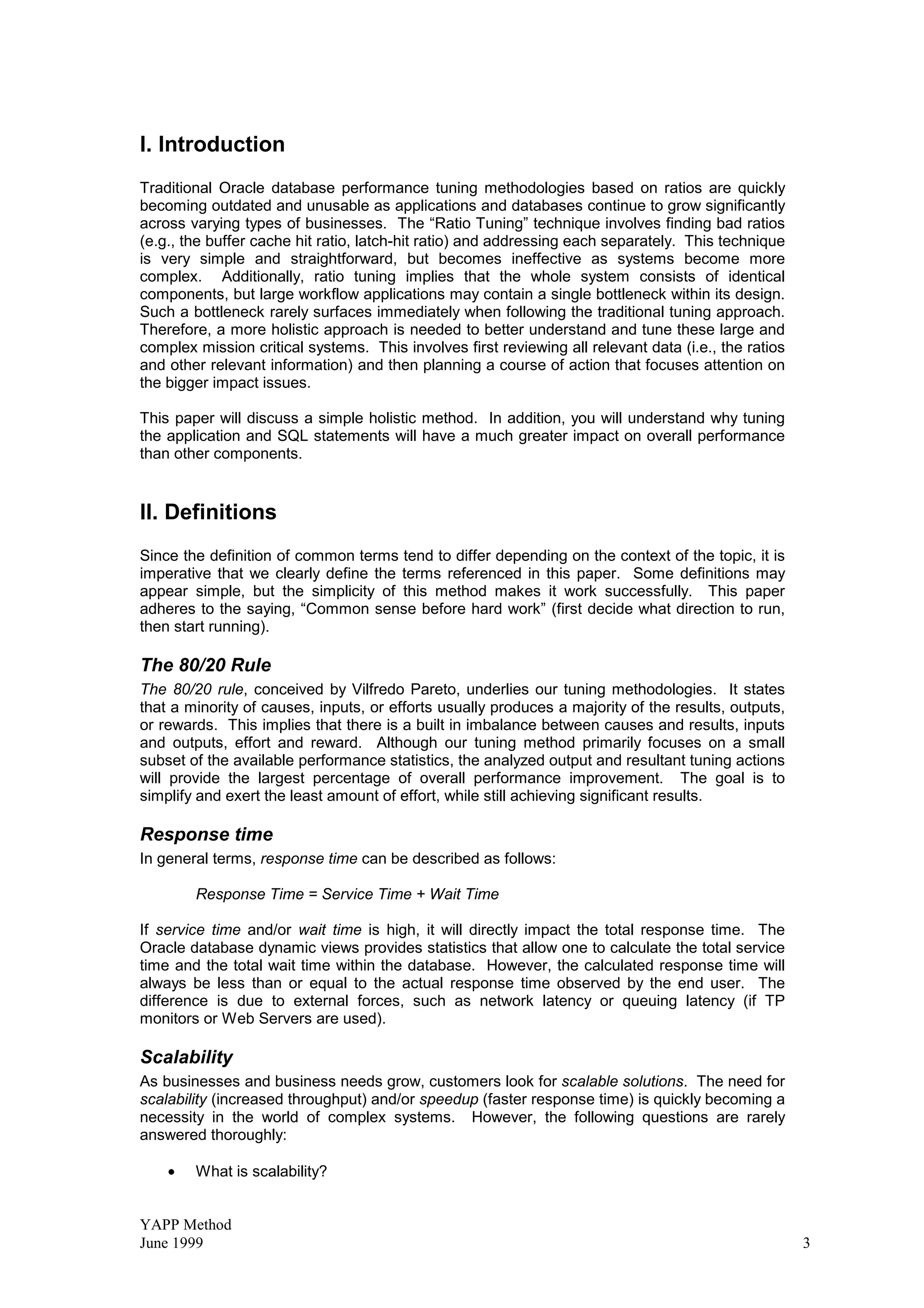



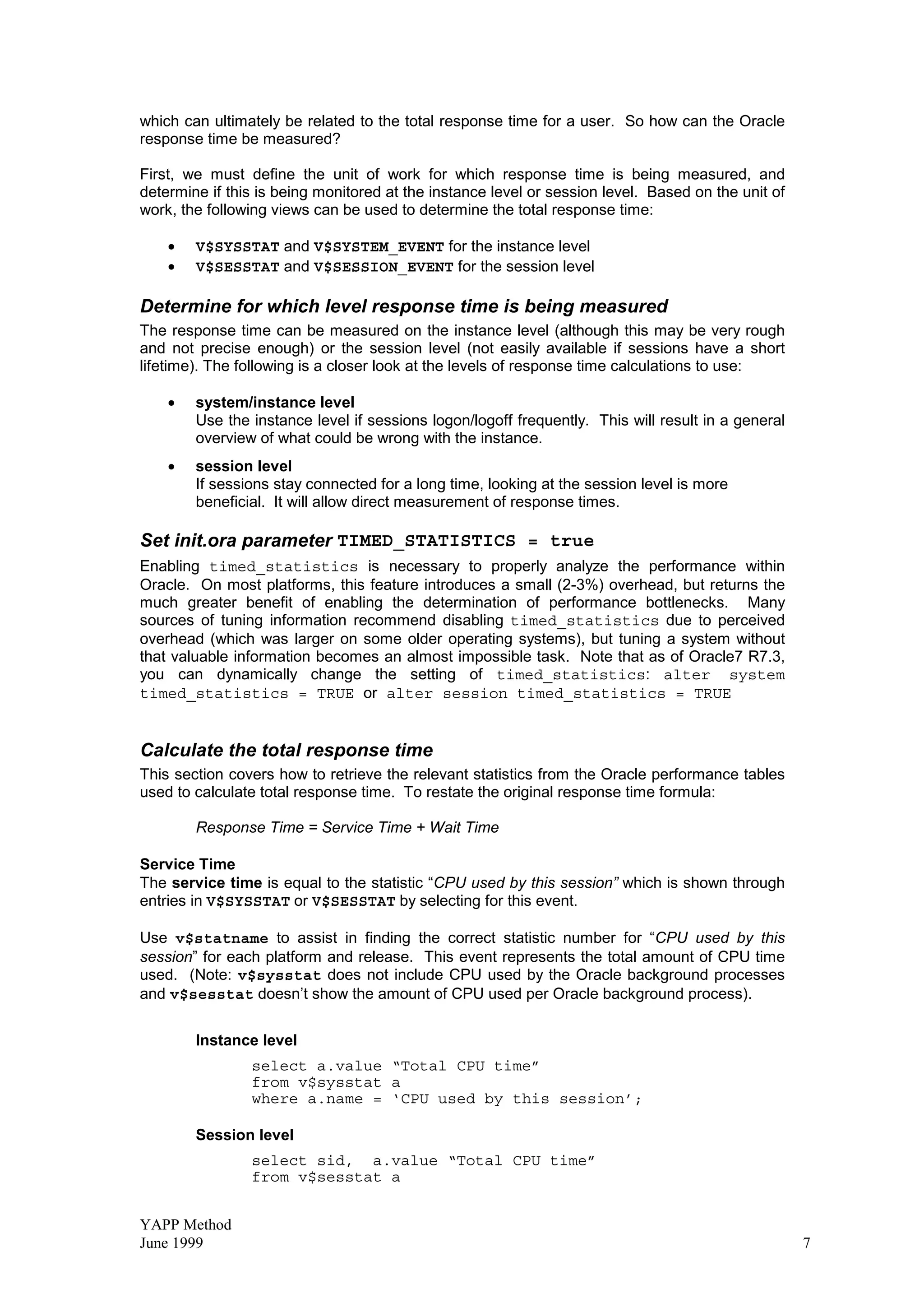


![YAPP Method
June 1999 10
In Oracle7, one cannot distinguish between hard and soft parses. In Oracle8,
parse count is divided into two statistics: parse count (total) and parse count
(hard). By subtracting the parse count (hard) from parse count (total) one can
calculate the soft parse count.
• execute count
This represents the total number of executions of Data Manipulation Language
(DML) and Data Definition Language (DDL) statements.
• session cursor cache count
The total size of the session cursor cache for the session (in V$SESSTAT) or the
total size for all sessions (in V$SYSSTAT).
• session cursor cache hits
The number of times a statement did not have to be reopened and reparsed,
because it was still in the cursor cache for the session.
From these statistics, the percentage of parses vs. executes can be calculated (parse
count/execute count). If this ratio is higher than 20%, consider the following:
• ensure the application is using bind variables. By using bind variables, it is
unnecessary to reparse SQL statements with new values before re-executing. It
is significantly better to use bind variables and parse the SQL statement once in
the program. This will also reduce the number of network packets and round trips
[This reason becomes less relevant with Oracle8 OCI.] It will also reduce
resource contention within the shared pool.
• if using Forms, make sure that Forms version 4.5 (or higher) is used
• if applications open/re-parse the same SQL statements and the value of ‘session
cursor cache hits' is low compared to the number of parses, it may be useful to
increase the number of cursor cache for the session. If no hit ratio improvement
results, lower this number to conserve memory and reduce cache maintenance
overhead.
• check pre-compiler programs on the number of open cursors that they can
support (default = 10 in some cases). Also check if programs are pre-compiled
with release_cursors = NO and hold_cursors = YES
recursive cpu usage
This includes the amount of CPU used for executing row cache statements (data
dictionary lookup) and PL/SQL programs, etc. If recursive cpu usage is high, relative to
the total CPU, check for the following:
• determine if much PL/SQL code (triggers, functions, procedures, packages) is
executed. Stored PL/SQL code always runs under a recursive session, so it is
reflected in recursive CPU time. Consider optimizing any SQL coded within those
program units. This activity can be determined by querying V$SQL.
• examine the size of the shared pool and its usage. Possibly, increase the
SHARED_POOL_SIZE. This can be determined by monitoring V$SQL and
V$SGASTAT.
• set ROW_CACHE_CURSORS. This is similar to session cached cursors and
should be set to a value around 100. Since there are only some 85 distinct data
dictionary SQL statements executed by the server processes, higher values will
have no effect.
Other CPU
This composes of CPU time that will be used for tasks such as looking up buffers,
fetching rows or index keys, etc. Generally “other” CPU should represent the highest
percentage of CPU time out of the total CPU time used. Also look in v$sqlarea2
/v$sql
2
It is better to query from V$SQL since V$SQLAREA is a GROUP BY of statements in the
shared pool while V$SQL does not GROUP the statements. Some of the V$ views have to
take out relevant latches to obtain the data to reply to queries. This is notably so for views](https://image.slidesharecdn.com/yappmethodology-anjokolk-220209091419/75/Yapp-methodology-anjo-kolk-10-2048.jpg)


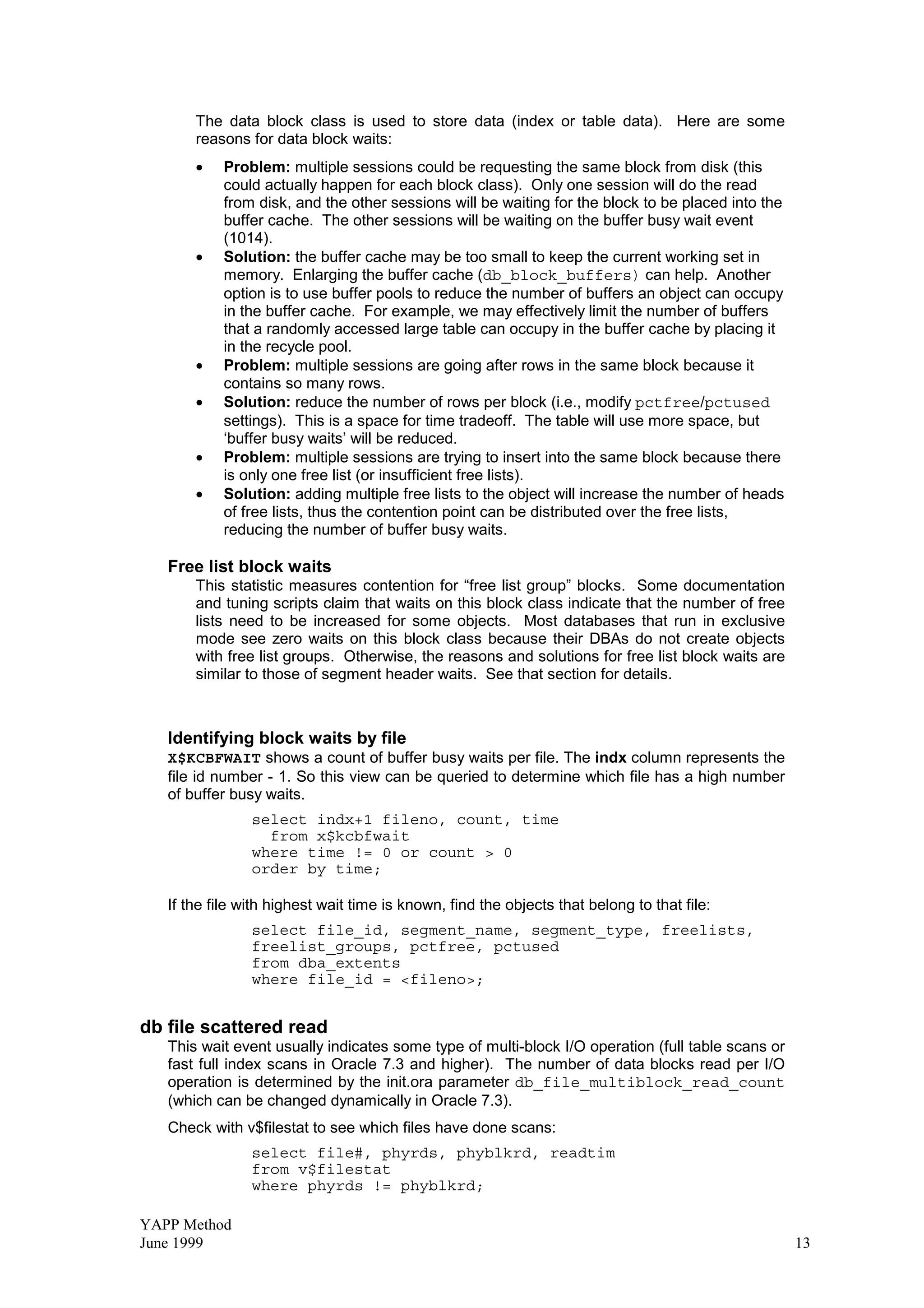






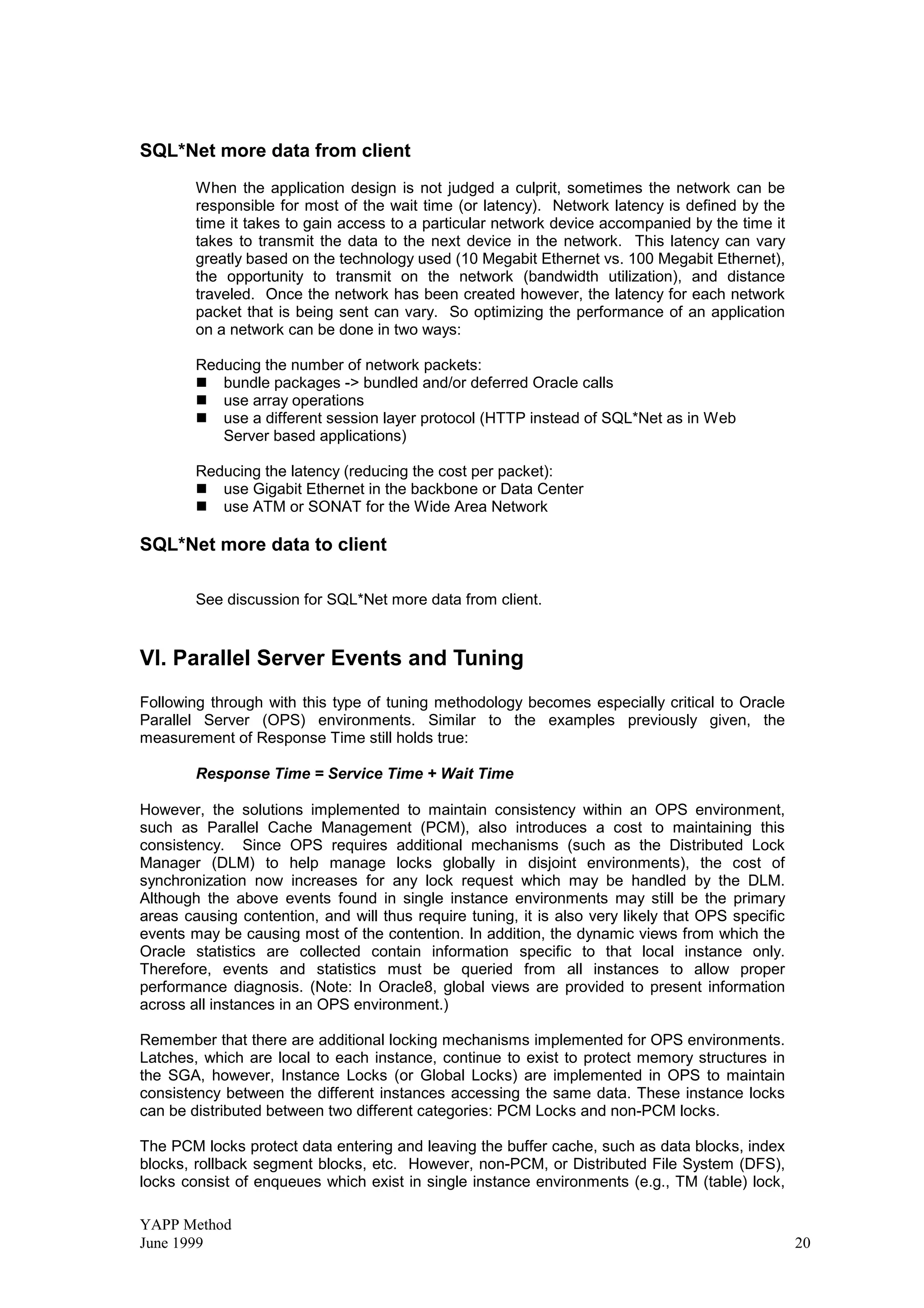

![YAPP Method
June 1999 22
It is also feasible to use the event DBWR cross instance writes from V$SYSSTAT to
determine the number of writes taking place due to ‘pings’. In order to obtain a percentage of
writes done for remote requests compared to total writes done for an instance:
% of writes due to pings = DBWR cross instance writes/physical writes
select y.value All Writes,
z.value Ping Writes,
z.value/y.value “Pings Rate
from v$sysstat y,
v$sysstat z
where z.name = 'DBWR cross instance writes'
and y.name = 'physical writes';
Note: Ping Rate value measures FALSE pinging activity ( 1 indicates false pings, 1
indicates soft pings)
To identify blocks that have a high ping rate and their corresponding class, query the view
V$BH. If PCM lock adjustments are needed, then modify the appropriate Global Cache (GC_)
parameter that corresponds to the particular block class.
Block Class Meaning GC Parameter
1 Data Blocks GC_DB_LOCKS,
Contains data from indexes or tables GC_FILES_TO_LOCKS
2 Sort Blocks - Contains data from on
disk sorts and temporary table locks. [no PCM locks needed]
3 Save Undo Blocks GC_SAVE_ROLLBACK_LOCKS
4 Segment Header Blocks GC_SEGMENTS
5 Save Undo Header Blocks GC_TABLESPACES
6 Free List Group Blocks GC_FREELIST_GROUPS
7 System undo Header Block GC_ROLLBACK_SEGMENTS
System Undo Blocks GC_ROLLBACK_LOCKS
Total number of pings (XNC - X to Null count) for each block where XNC !=0
Note: Once a block completely exits the cache (i.e., there are no versions of the block left in
the buffer cache), the XNC count gets reset to 0. Therefore it will be important to monitor this
view during regular intervals to obtain a better indication of blocks which are pinged
excessively.
Pings per file / block
select file#, block#, class#, status .xnc count
from v$bh a
where b.xnc!=0 and status in (‘XCUR’, ‘SCUR’)
order by xnc, file#, block#;
Once the file and blocks causing the highest amount of contention are identified, determine
the corresponding object and how that object is currently being accessed by querying V$SQL.
To determine the corresponding object name and type:
select segment_name, segment_type
from dba_extents
where file_id=file#
and block# between block_id and block_id + blocks – 1;
To determine the type of SQL statements being executed:](https://image.slidesharecdn.com/yappmethodology-anjokolk-220209091419/75/Yapp-methodology-anjo-kolk-22-2048.jpg)



